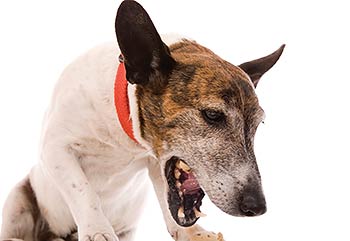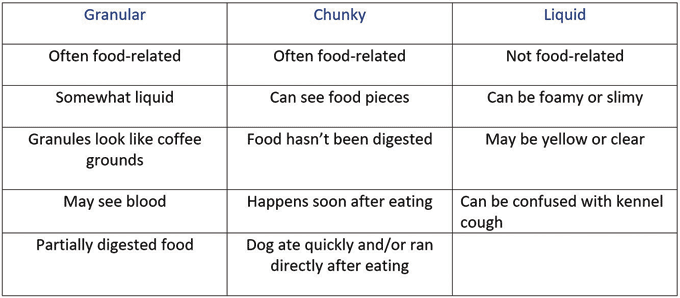 If you’ve been a pet parent for any length of time, chances are you’ve cleaned up doggy vomit at least once, because when it comes to canine companions, “heaving happens.” Some dogs try to avoid doing the deed in the house and alert their human before it occurs. Others let go wherever they happen to be when they feel the urge, including on that expensive couch, your favorite chair, freshly changed bed sheets, the carpet, and so on. If you’ve been a pet parent for any length of time, chances are you’ve cleaned up doggy vomit at least once, because when it comes to canine companions, “heaving happens.” Some dogs try to avoid doing the deed in the house and alert their human before it occurs. Others let go wherever they happen to be when they feel the urge, including on that expensive couch, your favorite chair, freshly changed bed sheets, the carpet, and so on.
When a dog vomits, it can occur out of the blue with no warning, or at the end of a coughing or gagging spell. Thankfully, healthy, well-cared for dogs don’t throw up often, so it can take their humans by surprise when it happens. In fact, many pet parents aren’t quite sure what just happened when something suddenly flies out of their dog’s mouth, nor are they aware there’s a difference between vomiting and regurgitating.
Having this information can be very helpful when you’re deciding whether you should call your veterinarian, and what to tell him or her at your appointment. If possible, it’s a good idea to take a video of the event and bring it with you to your appointment. It may seem weird to grab your cell phone or camera to memorialize the event, but that gross image or video can help your vet size up the situation more quickly.
Vomiting vs. Regurgitating
Your veterinarian must first determine whether your dog is really vomiting (which is how just about every pet parent describes it) or is instead regurgitating. It’s very important to make this distinction because the problems have different causes and different treatment approaches.
Vomiting is characterized by the forceful ejection of stomach and upper intestinal contents, typically contains yellow bile or partially digested dog food, and has a sour smell.
If your dog is getting ready to vomit, he feels nauseous. His abdominal walls are beginning to contract. He may drip or drool saliva or begin licking his lips right before he retches. Often there’s a heaving motion in which the abdominal muscles begin to contract several times before he empties the contents of his stomach.
If your dog regurgitates, she’ll simply open her mouth and voila, there on the floor (or wherever) will be a portion of the undigested food she just swallowed or the water she just drank. The stuff on the floor, called regurgitus, originates from either the esophagus or the pharynx (the back of the throat), which is why sometimes it’s shaped like a tube. It’s typically a mixture of food, saliva, and sometimes mucus — but not bile.
The takeaway here is that there’s usually no warning with regurgitation — for your dog or for you. It’s passive, whereas vomiting is an active process.
Believe it or not, there’s also a third type of “discharge” called expectorating. If your dog coughs, either once or several times, and then produces a blob of mucus, she is expectorating, which is very different from regurgitating or vomiting. The key with expectoration is that there’s always a cough involved.
7 Triggers for Vomiting in Dogs
Dogs who’ve been eating the same food for long periods may throw up if a sudden switch is made to their diet (or they consume a new food item), or if they’ve developed a sensitivity to an ingredient in their diet. The longer its been since you switched the slower your transition should be to new food.
If your dog eats something potentially toxic, like a poisonous plant or medication or chocolate, he may vomit, and in fact, in this case it could save his life.
Grass-eating, which many dogs seem to do when they have an upset stomach, can trigger vomiting. They know instinctively that eating grass will make them throw up and throwing up will make them feel better.
One of the most common reasons dogs vomit is dietary indiscretion, otherwise known as counter surfing, dumpster diving or ingesting nonfood items like toys, socks, sticks, rocks, etc.
Dogs who eat too fast typically throw up more often than average, along with dogs who are allowed to exercise vigorously right after a meal. It’s important not to let your dog engage in strenuous exercise or play for an hour after eating, to avoid not only vomiting, but the much more serious problem of bloat (gastric dilatation volvulus).
Some dogs develop motion sickness, which can cause vomiting, as can extreme fear or anxiety, which is a much more serious problem than people realize.
 |
| Three types of dog vomit |
Other, potentially very serious reasons a dog vomits include a blockage in the stomach or intestines; inflammatory bowel disease (IBD); a disease of the kidneys, liver, or pancreas; a middle ear problem (creating vertigo); meningitis; or a brain tumor.
If your dog very occasionally throws up and you can identify the cause as eating too fast or eating something he shouldn’t have (that isn’t potentially toxic), if he’s otherwise healthy, there’s no need to panic. If he starts eating what he just threw up, it’s most likely a case of vomiting due to eating too fast, and it’s fine (if gross) to let him do this.
However, anything outside this scenario — such as frequent vomiting or vomiting accompanied by other symptoms like loss of appetite or lethargy — require a visit to your veterinarian.
Causes of Regurgitation
Even though regurgitation can seem more benign than vomiting, it can actually be a sign of a serious underlying disorder. A disease of the esophagus is most often the cause and is either the result of an obstruction or a motility problem. The esophagus can be obstructed by a foreign body, stricture, vascular abnormality, or, less commonly, a tumor.
Motility disorders or problems with the muscle contractions of the esophagus can be congenital or acquired. An acquired motility disorder can be caused by esophagitis (inflammation of the esophagus), hypoadrenocorticism (Addison’s disease), lead toxicity, organophosphate toxicity, myasthenia gravis (a neuromuscular disorder), and possibly hypothyroidism.
An immune-mediated condition called megaesophagus also causes regurgitation, as can some cases of gastroesophageal reflux disease (GERD).
Though uncommon, regurgitation can also be caused by pharyngeal dysphagia, which is a swallowing disorder. Dogs with this condition can have difficulty or pain when swallowing, causing them to cough or gag when they try to swallow. Pharyngeal dysphagia can be the result of a neuromuscular disorder, a tumor on the pharynx, an anatomic abnormality, or trauma.
Different Problems, Different Resolutions
As you can see, vomiting and regurgitation are actually very different problems. The reasons a dog vomits are wide-ranging but are much different than the reasons she regurgitates, so obviously there are a wide range of interventions and treatment options, depending on the root cause.
In an otherwise healthy pet, the tendency to vomit is usually tied to the diet, dietary indiscretion, possibly a toxin or foreign body, or a developing condition like inflammatory bowel disease. Regurgitation happens for reasons unrelated to the diet or the health of the lower gastrointestinal (GI) tract.
The diagnosis and treatment of the two problems are quite different as well, which is why it’s important to recognize one from the other and pass on your observations to your veterinarian so he or she can take the appropriate action.
Dog-Friendly Walks/Hikes
in the Moab Area |
Corona Arch - Easy/Moderate. 1.3 Miles one way. Trailhead is 25 minute drive from Moab.
North on US-191 to Potash Road (Utah 279).
Mill Creek Pathway - Easy. 1.1 Miles. Little to no driving. Starts at the intersection of 100 South and 100 West,
a block off of Main Street.
Portal Overlook - Hard. 2.0 Miles one way. Trailhead is 20 minute drive from Moab.
North on US-191 to Potash Road (Utah 279).
Grandstaff Canyon - Moderate. 2.0 Miles one way. Trailhead is 10-minute drive from Moab.
North on US-191 to the River Road (Utah 128) |
|